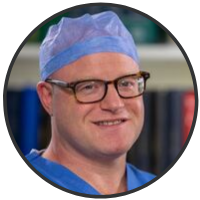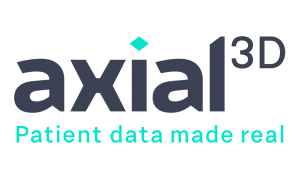Outsourcing 3D printing for complex transplant procedure preparation

In this interview, Consultant Transplant Surgeon, Tim Brown (Belfast City Hospital, Northern Ireland), explains how he uses an outsourced medical 3D printing service provider to produce models for transplant procedure planning, rehearsal and referral.

Biography

My name is Tim Brown, I am a Consultant Transplant Surgeon in Belfast City Hospital (Belfast, Northern Ireland) and I have been using 3D-printed models now for the last 2 years to guide my practice in transplantation and complex renal surgery.
>> Find out more about 3DMedLIVE
Register as a member of 3DMedNet for exclusive 3DMedLIVE updates
What is your background with medical 3D printing?
We were introduced to Axial3D (Belfast, Northern Ireland) a number of years ago. They made us aware of the technology as before we met Axial3D, we really didn’t use it all. In fact, we had not heard about it before. They showed us what the case possibilities were: when we found a suitable case had come forward, we discussed with Axial3D the best way to image and then create a model in order to help us.
What was it, specifically, that attracted you to the technology?
We all work off 2D imaging at the moment, using CT scanning, x-rays and things like that. When we look at a 2D image, we are, in our heads, not truly reconstructing those in the 3D space. Whenever I look, for example, at a donor nephrectomy on a CT scan, I am creating a 3D image in my own head as to what I think I am going to see whenever I get into the patient.
To use an analogy, if you imagine you and I reading the same James Bond book, I have a picture of what James Bond looks like in my head. When I give you the book to read you then develop a picture in your head of what James Bond looks like. We have digested the same information but most likely have very different appearances in our heads of what the actual image of James Bond is. To me, 3D imaging standardizes the approach in interpreting the patient’s anatomical detail and takes away unnecessary variability from one surgeon’s anatomical interpretation from another.
What surgical challenges does 3D printing help you to overcome?
Surgical challenges can be hugely influenced by pre-operative planning. Whenever we have complex tumors within organs or blood vessels, 3D printing gives us a very nice way of actually looking at the anatomy in-hand and potentially guiding where we are going to make incisions, what we are going to do, how do we get ourselves out of trouble if it arises.
Are there any limitations of the 3D technologies you use?
The first response to that question would be that I don’t think 3D printing is necessary for every case. I think that 3D imaging has very certain, specific applications for complex surgery, otherwise what you are doing is potentially wasting resources. Now, having said that, the flip side is that if we are not using the resource regularly enough, it can sometimes be difficult to get access to this and I would like to see easier access.
Certainly, in my own practice, with Axial3D we have created a really good interface where you can click a couple of buttons and upload patient imaging data and they will then turn around and model it very rapidly for you. Axial3D take 2 or 3 days and that’s I think probably as quickly as you can hope to achieve, but what I would like to see in the future is to be able to have a 3D model printed in the afternoon or the day a patient comes to see me.
At the minute, 3D imaging really compliments elective surgery and I would like to have that available for emergency imaging. Having more access to 3D printing on a more rapid basis, I think, would be a huge advantage.
What changes to the technology would you like to see in order for your work in 3D printing to be able to progress?
As I said before, I have a fairly very good relationship with Axial3D. I discuss my needs and they tailor the service to meet them. I provide the imaging and they provide the model for me in a way that is a tailored situation.
I don’t really know much about the software side of things and so I wouldn’t like to really comment about that. In terms of improvement and technology development, I think I speak for all transplant surgeons when I say that if we were able to get the technology to where it’s not just about printing plastic models, but if we were to have tissues and organs 3D printed which have been genetically modified or tissue engineered for each individual patient, that would be a great development. It would mean that patients would not need to take immuno-suppression drugs; we would not need to wait for a donor to come forward and the risks of disease transmission, tumor transmission and infection transmission from potentially high risk donors would be greatly reduced, if not removed.
How do you envision 3D printing technologies evolving in your field or specialism?
If we are able to achieve the Holy Grail of patient specific tissue engineering and biomedical 3D printing, as well as 3D modeling then that will be a superb thing for me. I could be doing elective surgery for dedicated patients on a day list rather than in the middle of the night and they will have no sort of long term dialysis burden. Access to transplantation will be so much more widespread and we wouldn’t have a huge gap between supply and the demand of potential organ availability.
Do you have any final comments about the application of 3D printing in your field of specialism?
I would advocate that 3D printing has the advantage of removing inter-operator variability and allows more thorough pre-operative planning. A further effect, which I am beginning to understand more recently, also surrounds patient education. Demonstrating a patient’s own anatomy to them with specific reference to the problems that they face is hugely empowering when it comes to making decisions about their own management. 3D models are much easier for most people to understand when compared with CT imaging and so, with understanding, comes autonomy over their body and decision making in relation to that. It is very rewarding as a doctor to have that sort of collaborative input from a patient.
Where would you recommend others who might be interested in getting involved in what you are doing to find out more?
Axial3D are my go-to people: they are hugely talented and immensely passionate about what they do. Whenever I discuss things with them, I usually end up leaving the conversation feeling refreshed and abuzz with their zest for what they do which is really quite unusual in the NHS! They perform a tailor-made service and they will go the extra mile in terms of trying to get you what you want. I can’t recommend them highly enough and if anybody needs a resource, they would be the first people that I would ever suggest going to.
Why do you think it is important to share your story and experience with 3D printing in the surgical field?
I don’t want to flatter myself, but it’s been a very interesting journey so far, it’s a real life journey. Hopefully there are practical lessons that I have learnt in terms of what applications the technology has and how it’s used. I think I have learned a fair bit that I can then share with people who hopefully will find it either interesting or useful.
Why are events like 3DMedLIVE important in progressing the field and the technology?
Well, I think it’s very important for people to get together and discuss real life problems and events like 3DMedLIVE act as forums or hubs for people with like-minded ideas to share problems, perhaps finding solutions they haven’t thought of before.
What are you most looking forward to about 3DMedLIVE 2019, do you have any highlights for the program so far?
Yes, I am quite looking forward to seeing how other people use the technology and seeing what other applications it’s available for, especially with tissue modeling.
The opinions expressed in this feature are those of the interviewee and do not necessarily reflect the views of 3DMedNet or Future Science Group.






